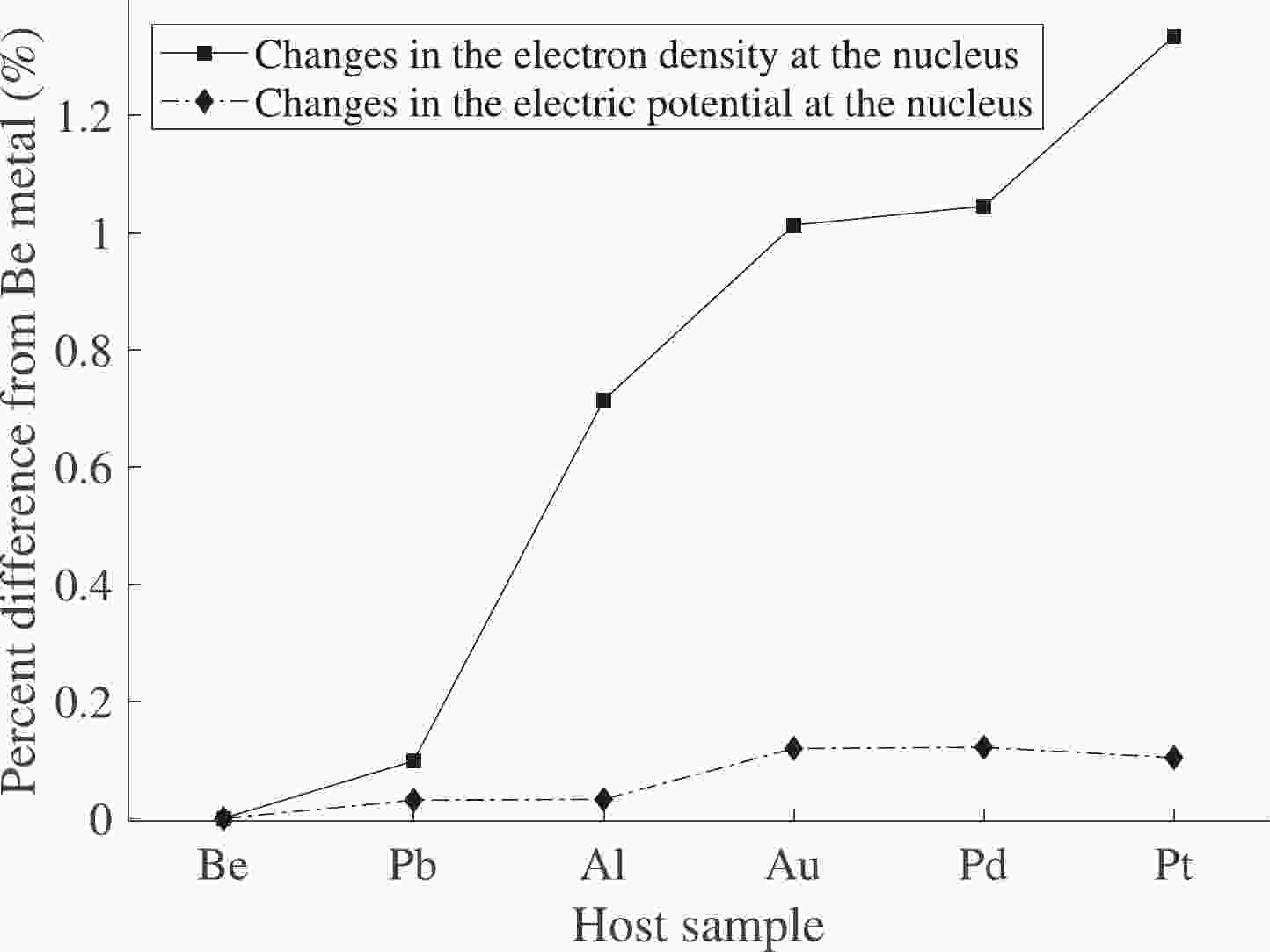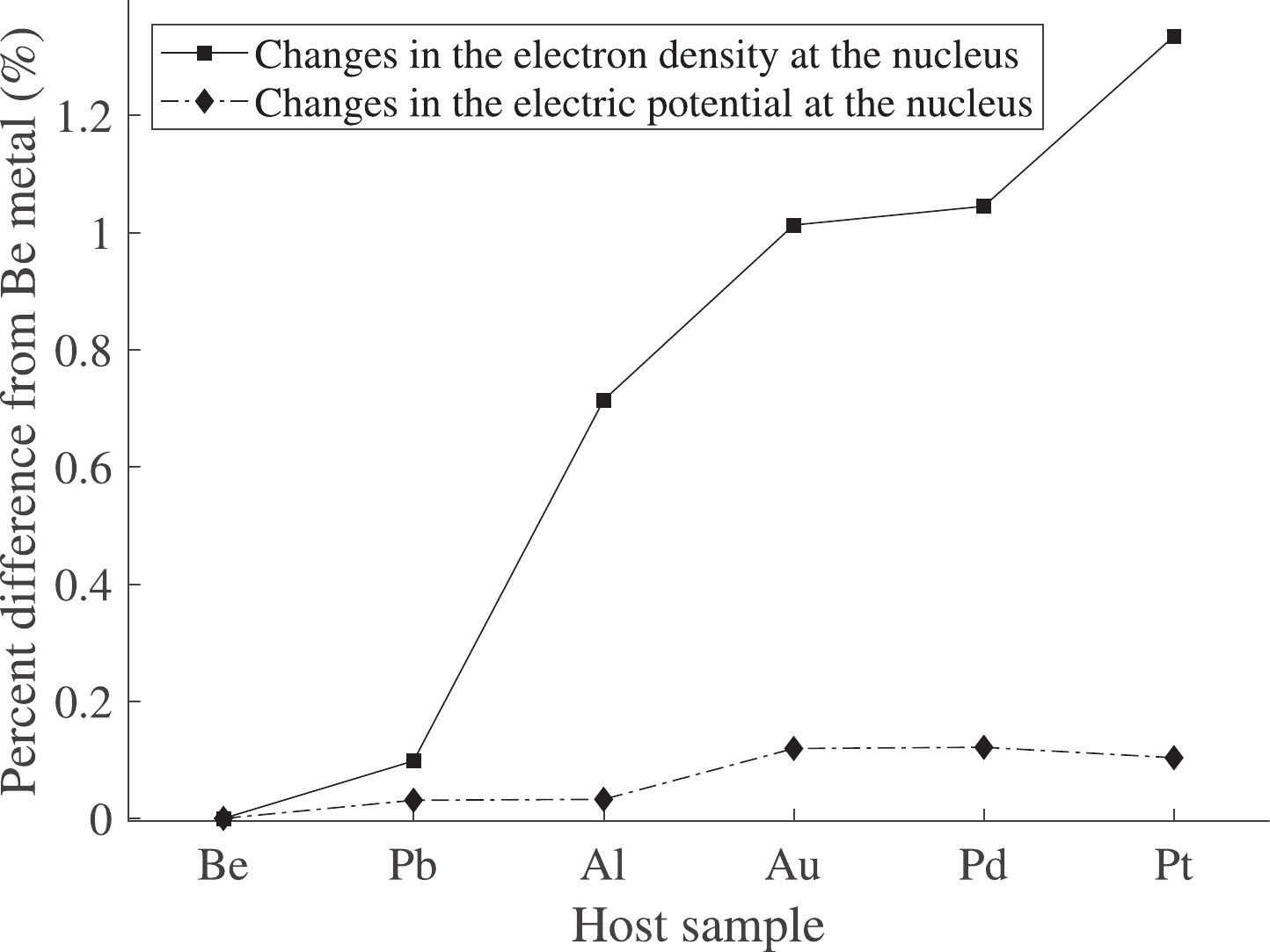-
It is generally known that the rate of decay is independent of external conditions. Among various types of nuclear decays, orbital electron capture (EC) and internal convention (IC) are slightly affected by external conditions, since these processes are sensitive to the chemical state of the atom [1].
In 1947, Segrè [2] and Daudel [3] first suggested that the decay rate of a radioactive nucleus can be changed in EC and IC processes. The nuclear decay rate can be dependent on the chemical environment. For light elements such as 7Be, the change in electron distribution might be considerable. The
$(1s)^2 (2s)^2$ electron shell of the Be atom is attractive to investigate changes in the nuclear half-life, since the contribution of 2s electrons is relatively large.From 1947, many scientists studied the change in 7Be half-life. A detailed review of previous works is given in Ref. [4]. Recently, it was found that the half-life of 7Be is changed via interaction with electronegative atoms [5]. Furthermore, Ohtsuki et al. [6,7] found that the decay rate of 7Be encapsulated in the center of
$ {\rm{C}}_{60} $ is accelerated. They attributed their results to the existence of$ \pi $ electrons and distribution of the electrons inside$ {\rm{C}}_{60} $ fullerene. Moreover, calculations of the change in 7Be decay rate are consistent with experimental data [4,5,8].Ray et al. [9] found that electron affinity of the media plays an important role in modifications of 7Be half-life by implanting it in the host media. Li et al. [10] found that 7Be half-life in Pd is approximately 0.8±0.2% shorter than its half-life in Au. Moreover, they discovered that decay rate of the 7Be in Pt is slower, i.e., approximately 0.17±0.13%, compared to that of 7Be in Al. Furthermore, confinement effects can be investigated in the change of 7Be decay rate. Ray et al. [11] investigated the confinement effect by measuring half-life of 7Be in Pb and Pd samples. It found that the half-life of 7Be in Pd is shorter than its half-life in Pb by 0.82±0.16%. Moreover, their results show an increase of ~0.2% in 7Be decay rate in the Pd structure compared to that of 7Be in the Pb sample, as confirmed with the density functional theory (DFT) method using WIEN2k code [12]. It shows that results computed using the linearized augmented plane wave (LAPW) method cannot explain the observed change in the decay rate of the 7Be nucleus in Pd compared to that of 7Be in Pb.
The EC decay rate is predicted in Ref. [13]. Moreover, change in the EC decay rate,
${\rm d}\lambda_{\rm EC}$ , which is proportional to electron density at the nucleus, is given by [14,15]$ {\rm d}\lambda_{\rm EC} = \left(\frac{\rho_e}{\rho_{e_{\rm ref}}}-1\right)\lambda_{\rm ref}, $

(1) where
$\lambda_{\rm EC}$ and$ \rho_e $ are the EC decay rate and electron density at the nucleus, respectively.In this paper, we present our results of investigation of electron affinity and confinement effects on modification of 7Be half-life in different host media. For this consideration, electron density at the 7Be nucleus is computed within the DFT framework. Moreover, our results are compared with experimental data. Furthermore, we calculate variations of the electric potential at the 7Be nucleus in all structures and compare those with the results for electron density at the nucleus.
-
Calculations were performed by using the BAND program in the Amsterdam Density Functional (ADF) package [16]. The BAND program is a separate program based on the DFT method for periodic systems, such as crystals, bulk materials, and polymers.
To obtain a good agreement with experiments, the meta generalized gradient approximation (meta-GGA) is used by including the Minnesota 2006 local (M06-L) functional. Moreover, the triple zeta plus polarization (TZP) functions are employed with a small frozen core. All-electron quadruple zeta plus four polarization (QZ4P), which is the most extensive and accurate basis set, is used in computations.
Relativity effects are also considered in computations. Relativity has a small effect on almost all properties; however, it may be important to calculate electron density at the nucleus in structures with heavy atoms. The spin-orbit coupling used in computations is the best level included in the package.
-
First, we investigated the equilibrium lattice constants by performing geometry optimization. Table 1 lists the basic parameters of the species. All simulated samples have a face-centered cubic (fcc) structure. All calculations are performed by taking the average electron density at the 7Be nucleus.
Sample Structure Lattice constant (Å) Electron affinity /eV Al fcc 4.05 0.43 Au fcc 4.07 2.308 Pd fcc 3.89 0.56 Pt fcc 3.92 2.125 Pb fcc 4.95 0.37 Table 1. Basic parameters of the host media [17].
Calculations are performed to obtain the minimum energy corresponding to the equilibrium lattice constants. Accordingly, results show that systems remain stable in the fcc structure with the Be atom implanted in them.
Results of the electron density at the 7Be nucleus, which are summarized in Table 2, show that the half-life of 7Be in the Pt sample is the lowest among the calculated environments.
Sample $\rho_e$ (e/Bohr3)

Percent difference from Be metal $\lambda_{\rm EC}$ (%)

$\Delta V_{c}$ 

Be 34.51 Al 34.76 0.71 0.033 Au 34.86 1.01 0.119 Pd 34.87 1.04 0.121 Pt 34.97 1.33 0.104 Pb 34.54 0.10 0.031 Table 2. Properties at the 7Be nucleus in host media.
-
To investigate the confinement effect on the half-life, we electron density at the 7Be nucleus in the Pd lattice is compared to that of the Pb structure, since the electron affinity of them is very low and similar. Results show that half-life of the 7Be is lower in Pd structure by 0.95%, which has a good agreement with experimental data within the uncertainty limits in Ref. [11].
Furthermore, electron density at the 7Be nucleus is obtained in the Al lattice. Our results show a 0.64% increase in the decay rate of 7Be in Al compared to that in the Pb structure. Moreover, one can predict that the half-life of 7Be decreases if the 7Be nucleus is compressed further in host media.
-
Recently, influence of the high-electronegativity atoms on 7Be half-life was investigated in Ref. [5]. The Be atom loses a large fraction of 2s valance electrons by interacting with high electronegativity atoms. Here, we studied the influence of the electron affinity of the media on the nuclear decay rate of 7Be.
For this investigation, electron density at 7Be in Al is compared with that in the Au structure. Both samples have an fcc structure with approximately the same lattice constant (as listed in Table 1). In contrast, the electron affinity of the Au media (2.308 eV) is considerably larger than that of the Al lattice (0.43 eV). Therefore, influence of the electron affinity on the decay rate of 7Be nucleus can be investigated by comparing electron density at the 7Be nucleus in two environments. The results show an increase of 0.29% in the 7Be decay rate in Au compared to that of 7Be in the Al sample.
Moreover, the effect of electron affinity on decay rate of 7Be is also confirmed by comparing electron density at the 7Be nucleus in Pd with that in the Pt lattice. Calculations predict a change in 7Be decay rate in the Pt sample, i.e., approximately 0.3%, relative to that in the Pd structure.
-
To explicitly explain the variation in electron density at the nucleus due to both effects, changes in the electric potential at the 7Be nucleus,
$ \Delta V_{c} $ , are also investigated.Figure 1 compares the variation in electron density and electric potential at the 7Be nucleus. It shows that variations in the electron density at the 7Be nucleus are usually consistent with changes in the electric potential at its nucleus.
-
In conclusion, DFT calculations of electron density,
$ \rho_{e}(0) $ , and electric potential at the beryllium nucleus predicted that electron affinity and confinement effects of the media can affect the electron density at the 7Be nucleus. Moreover, calculation results show that the decay rate of the 7Be nucleus is increased via interaction with high electron affinity media.Moreover, the Be atom is compressed by confining to the dimension of the host lattice. In general, the 2s valance electrons are pushed toward the
$^7{\rm Be}$ nucleus by compressing the Be atom; therefore, 2s electron density at the nucleus is increased. However, the situation can be complicated. The 2s electrons have a screening effect for 1s core electrons; thus, the nucleus encounters fewer 1s electrons, and 1s electron density at the nucleus is slightly reduced. Therefore, one expects that electron density at the nucleus increases with slight compression, while the 1s electron density at the nucleus can be decreased with increased compression. Moreover, 1s electrons are pushed toward the 7Be nucleus upon further compression; therefore, electron density at the 7Be nucleus is increased again.However, obtained results from DFT calculations show that compression of 7Be in host environments is not very complicated. Thus, decay rate of the 7Be nucleus can be increased by confining it further to the dimension of host lattice.
-
We have carried out accurate predictions for electron density at the 7Be nucleus in the host environment within first-principle calculations. The DFT computations show that variations in the 7Be decay rate in Pd and Pb within the uncertainty limits have a good agreement with the experimental data in Ref. [11], according to which results computed using WIEN2k code cannot predict the observed change in the experiment.
Furthermore, our results show that the half-life of 7Be can be changed with a change in the attractive effective potential. Computations show that the change in the decay rate of 7Be has a direct relation with the value of electron affinity of the host media. Moreover, confinement effects are investigated by comparing electron density at the 7Be nucleus in structures with the same lattice constant. According to this study, the half-life of 7Be is decreased with increased confinement of the Be atom.
Change in 7Be half-life in host media
- Received Date: 2021-01-06
- Available Online: 2021-06-15
Abstract: First-principle calculations within the density functional theory framework are used to study the probability of electron capture for the 7Be nucleus. For this purpose, electron density at the 7Be nucleus is computed in Al, Au, Pd, Pt, and Pb environments. Our results show that the half-life of 7Be is changed by implanting 7Be in host environments. Electron affinity of the media and confinement effects are responsible for the change in the half-life of 7Be nucleus. Moreover, electric potential at the 7Be nucleus is calculated. Results show that variations in electric potential are usually consistent with those in electron density at the 7Be nucleus.





 Abstract
Abstract HTML
HTML Reference
Reference Related
Related PDF
PDF
















 DownLoad:
DownLoad: